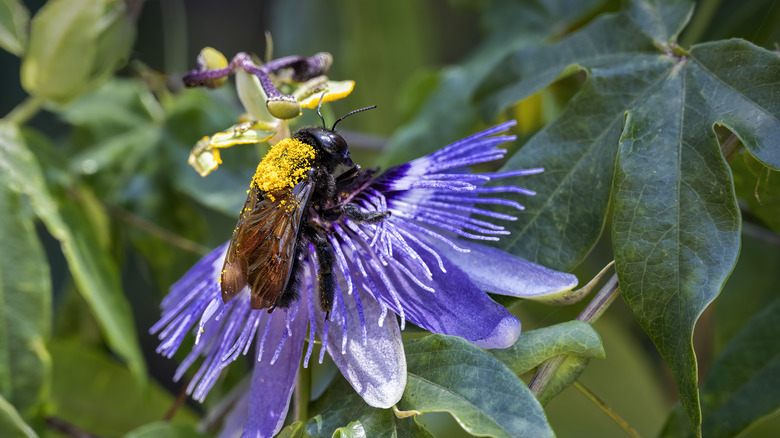You may know this vine by different names: maypop, purple passionflower, purple passion vine, and apricot vine are all common names for native passion flower (Passiflora incarnata L.). This perennial plant shows up along roadsides and fields, but it also makes a beautiful addition to the home garden where it is a favorite among pollinators. The unique qualities of the stunning blooms on passionflowers are incomparable and they have a similar scent to honeysuckle when they bloom in summer through fall, depending on the region.
While there are many cultivars in the Passiflora family, native purple passionflower is hardy in zones 7 through 10, although it can be grown farther north where it will die back to the ground in the winter, and spring up with new growth in late spring. Plants within this species include varying shades of purple, lavender, and yellow. If you are looking for a fast-growing vine that requires minimal maintenance, supports pollinators, and provides some privacy, consider adding passionflower to your outdoor space.
Benefits of passionflower

Passionflower is the host plant for several butterflies and moths. This means that these particular pollinators will only lay their eggs on this one type of plant because it’s the only food the larvae can eat once they hatch. In North America, this vine provides sustenance for gulf and variegated fritillary butterflies as well as banded and red-banded hairstreak moths. Hummingbirds will also visit the vine’s bold blooms for a tasty treat and the large, flat flowers provide the perfect spot for big, fluffy bumblebees to eat and rest.
You have probably heard of passion fruit, which does come from a passionflower plant, but only the hardy tropical varieties. Purple passionflower does produce fruits that are technically edible. Within the soft egg-shaped fruits are seeds encompassed in sweet, gelatinous liquid -– not exactly a hearty snack. The leaves, on the other hand, have been used for everything from poultices to soothing teas and calming tonics. With passionflower vines in your yard, you can grow your own relaxation tea.
Challenges of growing passionflower
Since passionflower is a perennial, it’s best to have the ideal location identified before you start planting, and that means understanding what you’re getting into. Despite all the benefits of passionflower, there is one significant challenge. Passionflower is an aggressive grower, producing vines up to 25 feet long in one season. Its roots also grow and spread underground, so once the plant is established, it can send out runners that pop up in your yard 10 feet or more from the parent plant. If you are picky about having a perfect lawn, passionflower is probably not something you want to add, but there are plenty of other vines that would be a better option in this situation.
As a native plant that thrives in roadside ditches and wild fields, passionflower does not do as well in planters. By nature, the roots are made to grow and spread, so keeping them confined may not provide the lush growth and aromatic blooms you want. Plants grown in the ground do not require special soil, fertilization, or extra water once they are established, but a passionflower in a container would.
Selecting the right spot to plant
Benevolent Medley/Shutterstock
Now that you know more about how passionflower grows, let’s discuss where it can grow. We suppose the simple answer would be “anywhere,” because that’s true, but in your yard, you’ll want to place it somewhere you can control the spread and gain the most benefits.
Passionflowers will grow well in partial shade to full sun, but you’ll get the most flowers if it’s in full sun all day. If you have a far corner of your yard with a fence, this may be an excellent place to plant passionflower. This plant is incredibly drought-tolerant, so once it’s established, you won’t have to water it. It’s a good vine for those spots where “nothing will grow.” Just make sure the runners won’t be a problem for your neighbors. We recommend planting it somewhere you will mow around to keep those runners from taking over. The three-lobed leaves and gorgeous blooms create the best display when they can grow vertically. Growing passionflower up a trellis around a patio can provide quick-growing privacy and shade on sunny days. This vine also works well to hide an ugly fence. The keys to picking a spot to plant passionflower are providing enough sun, someplace it can climb, and making sure you can manage it.
How to grow passionflower
Paulmaguire/Getty Images
Planting and growing native purple passionflower is the best part because it’s so easy! Make sure you select a location in full sun for the best results, but otherwise, this vine is incredibly low-maintenance. Whether you have clay soil, sandy soil, or somewhere in between, passionflower plants will easily take root. You will need to water it for the first few months any time the soil is dry 1 inch below the surface while the roots get established.
In areas that experience freezing temperatures, passionflower will die back to the ground. Once the vines have dried, just remove them to tidy up the space. Green tops will emerge from the soil in late spring or earlier, depending on where you live. You can add compost if you want to give your plants a boost or if you have particularly lean soil, but as with most native plants, fertilization is not necessary. It’s hard to find a more beneficial and low-maintenance vining plant than passionflower to attract a variety of pollinators to your yard.
